key Oldsmobile Achieva 1995 s Owner's Guide
[x] Cancel search | Manufacturer: OLDSMOBILE, Model Year: 1995, Model line: Achieva, Model: Oldsmobile Achieva 1995Pages: 340, PDF Size: 16.99 MB
Page 115 of 340
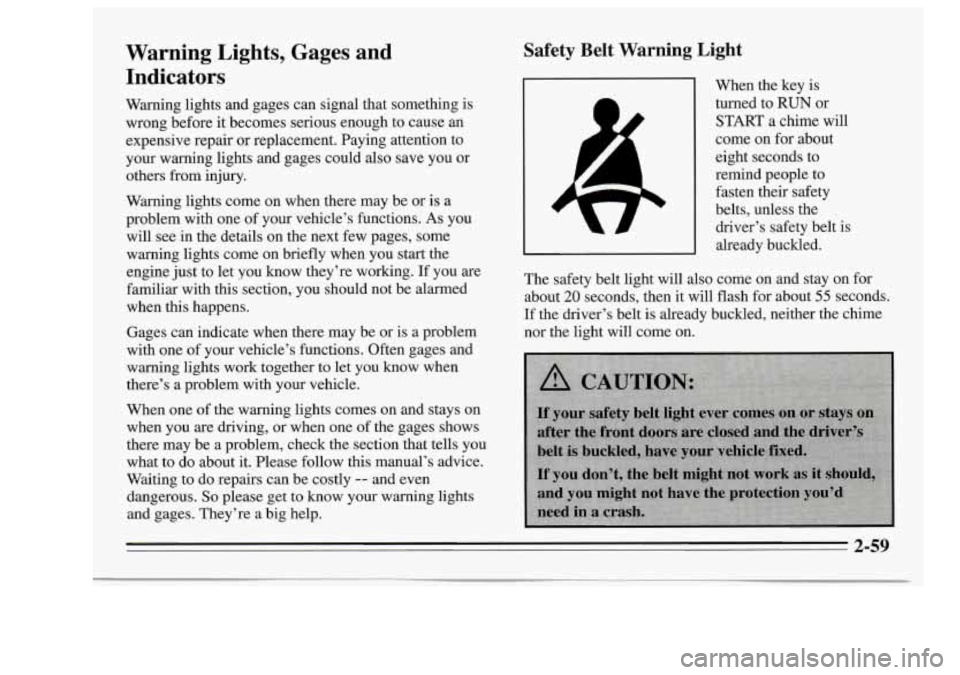
Warning Lights, Gages and
Indicators
Warning lights and gages can signal that something is
wrong before it becomes serious enough to cause an
expensive repair or replacement. Paying attention to
your warning lights and gages could also save you or
others from injury.
Warning lights come on when there may be or is a
problem with one of your vehicle’s functions.
As you
will see
in the details on the next few pages, some
warning lights come on briefly when you start the engine just to let you know they’re working. If you are
familiar with this section, you should not be alarmed when this happens.
Gages can indicate when there may be or is a problem
with one of your vehicle’s functions. Often gages and
warning lights work together to let you know when
there’s a problem with your vehicle.
When one of the warning lights comes on and stays on
when you are driving, or when one of the gages shows
there may be a problem, check the section that tells you
what to do about it. Please follow this manual’s advice.
Waiting to do repairs can be costly
-- and even
dangerous.
So please get to know your warning lights
and gages. They’re a big help.
Safety Belt Warning Light
When the key is
turned to
RUN or
START a chime will
come on for about
eight seconds to
remind people to fasten their safety
belts, unless the
driver’s safety belt
is
already buckled.
The safety belt light will also come on and stay on for
about
20 seconds, then it will flash for about 55 seconds.
If the driver’s belt is already buckled, neither the chime
nor the light will come on.
2-59
Page 124 of 340
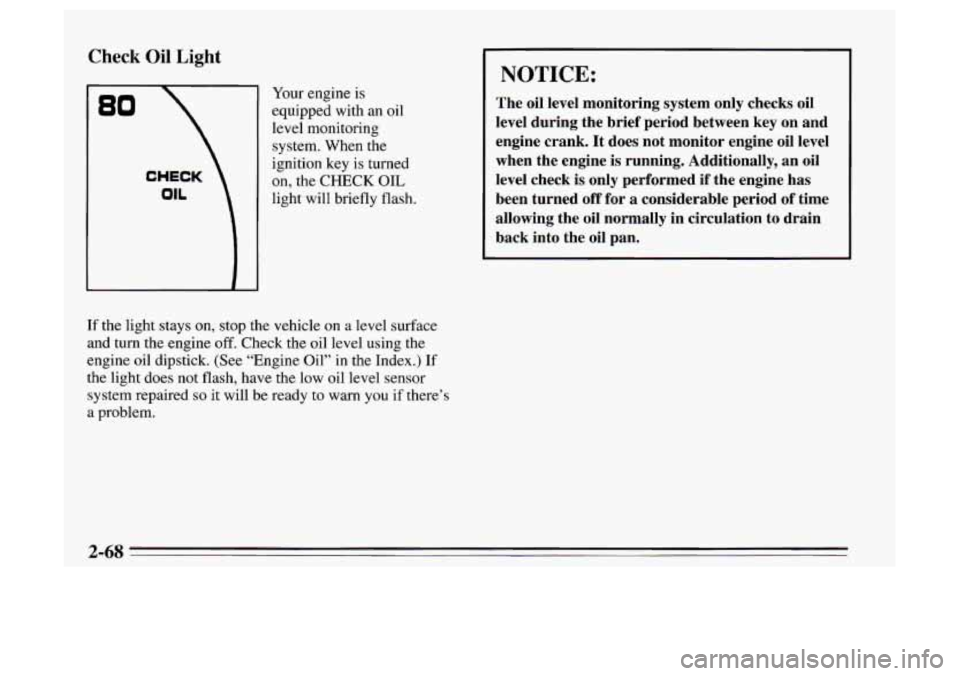
Check Oil Light
80
Your engine is
equipped with
an oil
level monitoring
system. When the
ignition key is turned
on, the CHECK
OIL
light will briefly flash.
If the light stays on, stop the vehicle on a level surface
and turn the engine
off. Check the oil level using the
engine oil dipstick. (See “Engine Oil” in the Index.)
If
the light does not flash, have the low oil level sensor
system repaired
so it will be ready to warn you if there’s
a problem.
I NOTICE:
The oil level monitoring system only checks oil
level during the brief period between key on and
engine crank.
It does not monitor engine oil level
when the engine is running. Additionally, an oil
level check is only performed if the engine has
been turned
off for a considerable period of time
allowing the oil normally in circulation to drain
back into the oil pan.
2-68
Page 146 of 340
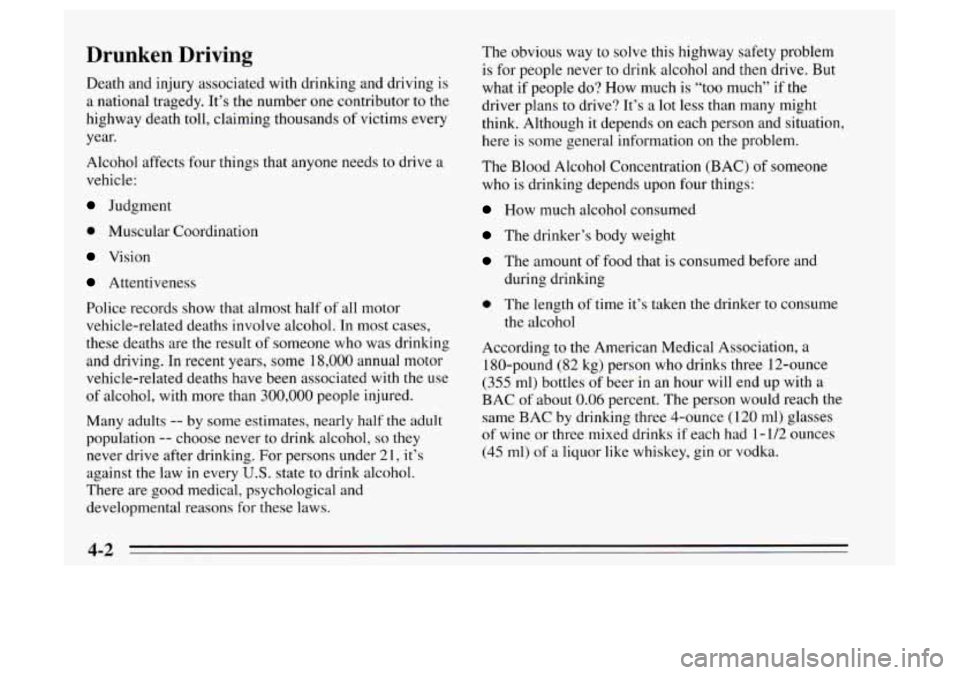
Drunken Driving
Death and injury associated with drinking and driving is
a national tragedy. It’s the number one contributor to the
highway death toll, claiming thousands of victims every
year.
Alcohol affects four things that anyone needs to drive
a
vehicle:
Judgment
0 Muscular Coordination
Vision
Attentiveness
Police records show that almost half
of all motor
vehicle-related deaths involve alcohol.
In most cases,
these deaths are the result of someone who was drinking
and driving.
In recent years, some 18,000 annual motor
vehicle-related deaths have been associated with the use
of alcohol, with more than 300,000 people injured.
Many adults
-- by some estimates, nearly half the adult
population
-- choose never to drink alcohol, so they
never drive after drinking. For persons under 2 1, it’s
against the law in every
U.S. state to drink alcohol.
There are good medical, psychological and
developmental reasons for these laws.
The obvious way to solve this highway safety problem
is for people never to drink alcohol and then drive. But
what if people do? How much
is “too much” if the
driver plans to drive? It’s
a lot less than many might
think. Although it depends
on each person and situation,
here is some general information on the problem.
The Blood Alcohol Concentration (BAC)
of someone
who is drinking depends upon four things:
How much alcohol consumed
The drinker’s body weight
The amount of food that is consumed before and
during drinking
0 The length of time it’s taken the drinker to consume
the alcohol
According
to the American Medical Association, a
180-pound (82 kg) person who drinks three 12-ounce
(355 ml) bottles of beer in an hour will end up with a
BAC of about 0.06 percent. The person would reach the
same BAC
by drinking three 4-ounce (120 nll) glasses
of wine or three mixed drinks if each had 1-1/2 ounces
(45 ml) of a liquor like whiskey, gin or vodka.
4-2
Page 171 of 340
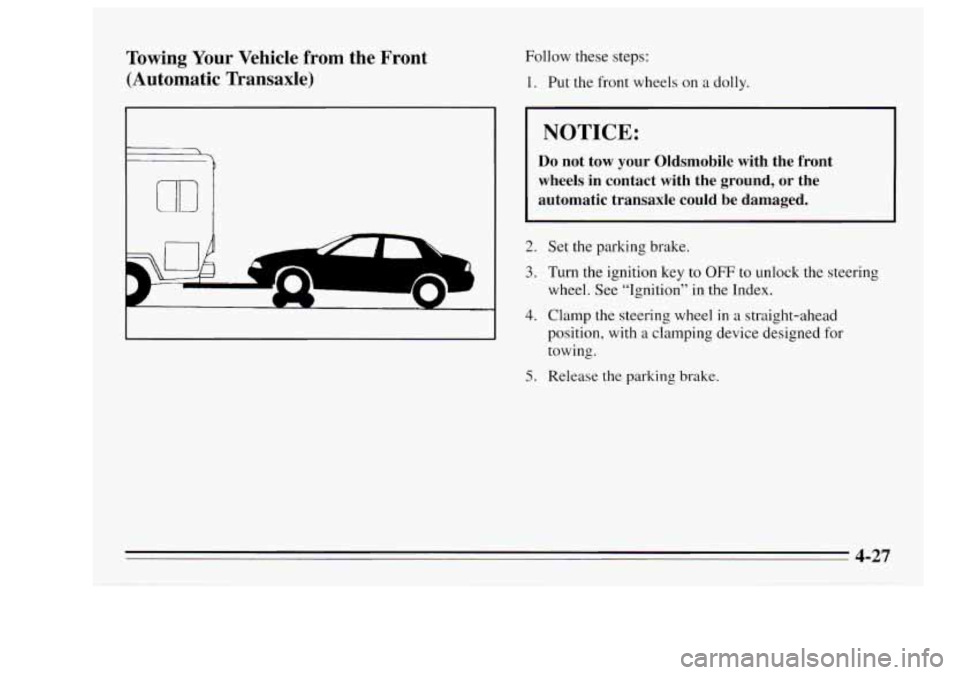
Towing Your Vehicle from the Front
(Automatic Transaxle) Follow these steps:
1. Put the front wheels on a dolly.
NOTICE:
Do not tow your Oldsmobile with the front
wheels in contact with the ground, or the
automatic transaxle could be damaged.
2. Set the parking brake.
3. Turn the ignition key to OFF to unlock the steering
wheel. See “Ignition” in the Index.
4. Clamp the steering wheel in a straight-ahead
position, with a clamping device designed
for
towing.
5. Release the parking brake.
4-27
Page 172 of 340
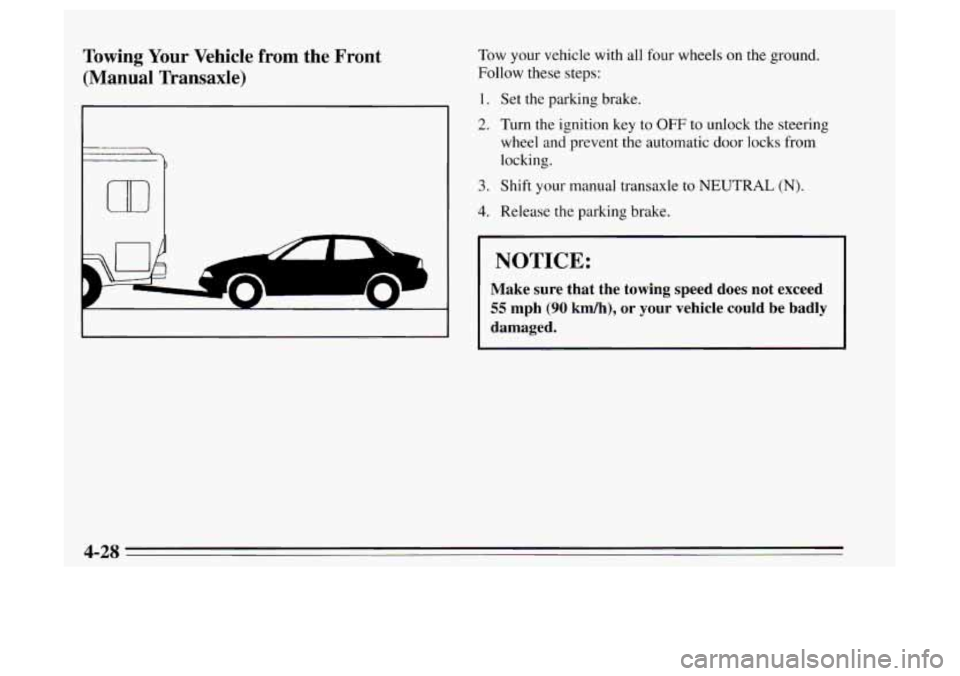
Towing Your Vehicle from the Front
(Manual Transaxle) low your vehicle with all four wheels on the ground.
Follow these steps:
1.
2.
3.
4.
Set the parking brake.
Turn the ignition key to
OFF to unlock the steering
wheel and prevent the automatic door locks
from
locking.
Shift your manual transaxle to
NEUTRAL (N).
Release the parking brake.
I
NOTICE:
Make sure that the towing speed does not exceed
55 mph (90 kmh), or your vehicle could be badly
damaged.
4-28
Page 183 of 340
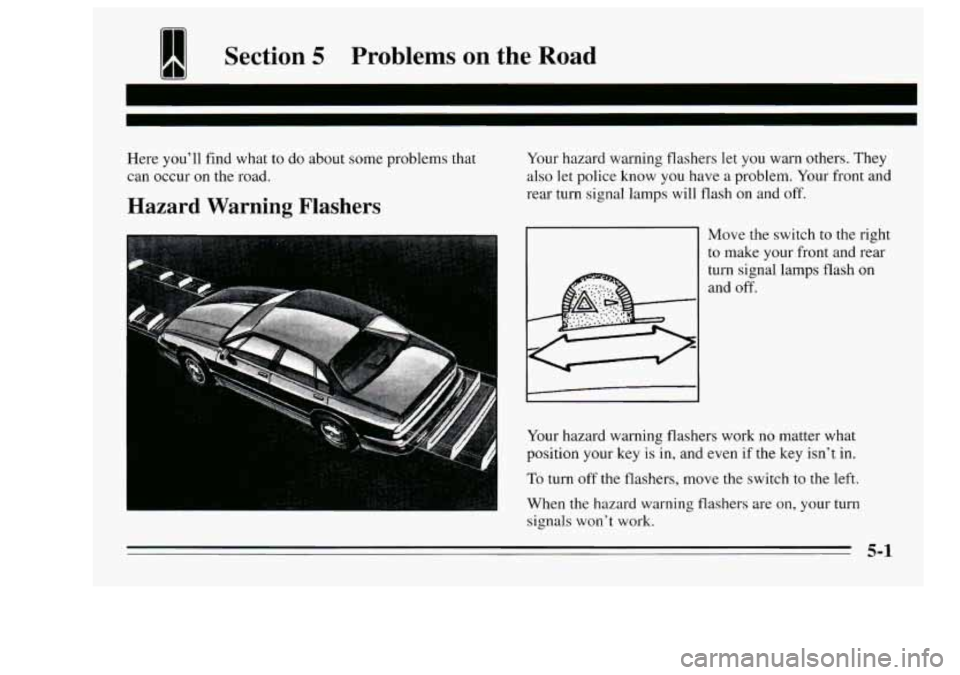
1 Section 5 Problems on the Road
Here you’ll find what to do about some problems that
can occur on the road.
Hazard Warning Flashers
Your hazard warning flashers let you warn others. They
also let police know you have a problem. Your front and
rear
turn signal lamps will flash on and off.
Move the switch to the right
to make your front and rear
II
turn signal lamps flash on
and off.
Your hazard warning flashers work no matter what
position your key
is in, and even if the key isn’t in.
To turn off the flashers. move the switch to the left.
When the hazard warning flashers are on, your
turn
signals won’t work.
5-1
Page 190 of 340
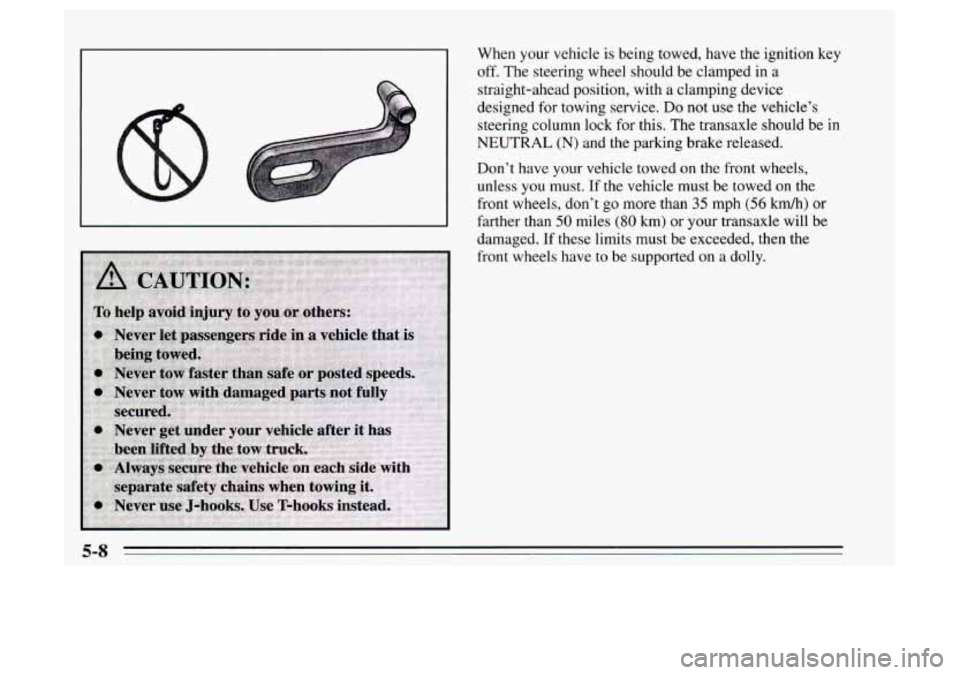
When your vehicle is being towed, have the ignition key
off. The steering wheel should be clamped in a
straight-ahead position, with a clamping device
designed for towing service. Do not use the vehicle’s
steering column lock for this. The transaxle should be in
NEUTRAL (N) and the parking brake released.
Don’t have your vehicle towed
on the front wheels,
unless you must. If the vehicle must be towed on the
front wheels, don’t go more than
35 mph (56 kmh) or
farther than
50 miles (80 km) or your transaxle will be
damaged.
If these limits must be exceeded, then the
front wheels have to be supported
on a dolly.
Page 305 of 340
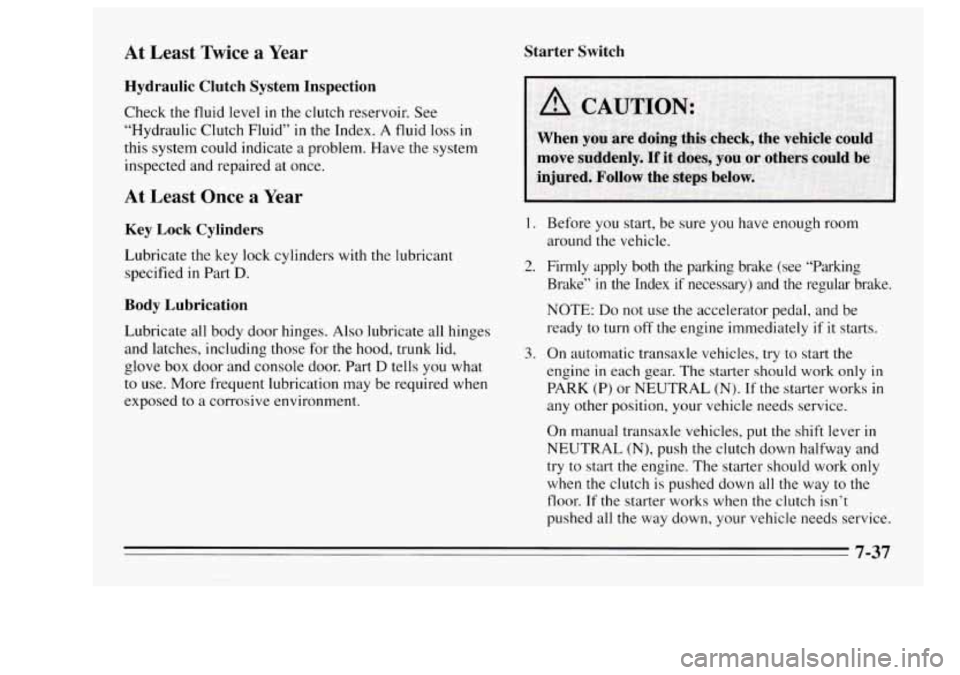
At Least Twice a Year Starter Switch
Hydraulic Clutch System Inspection
Check the fluid level in the clutch reservoir. See
“Hydraulic Clutch Fluid”
in the Index. A fluid loss in
this system could indicate a problem. Have the system
inspected and repaired at once.
At Least Once a Year
Key Lock Cylinders
Lubricate the key lock cylinders with the lubricant
specified
in Part D.
Body Lubrication
Lubricate all body door hinges. Also lubricate all hinges
and latches, including those for the hood, trunk lid,
glove box door and console door. Part
D tells you what
to use. More frequent lubrication may be required when
exposed to a corrosive environment.
I move suddenly. If it does, you or others could be I
1.
2.
3.
Before you start, be sure you have enough room
around the vehicle.
Firmly apply both the parlung brake (see “Parking
Brake”
in the Index if necessary) and the regular brake.
NOTE:
Do not use the accelerator pedal, and be
ready to turn off the engine immediately
if it starts.
On automatic transaxle vehicles, try to start the
engine
in each gear. The starter should work only in
PARK (P) or NEUTRAL (N). If the starter works in
any other position, your vehicle needs service.
On manual transaxle vehicles, put
the shift lever in
NEUTRAL (N), push the clutch down halfway and
try to start the engine. The starter should work only
when the clutch is pushed down all the way to the
floor.
If the starter works when the clutch isn’t
pushed all the way down, your vehicle needs service.
7-37
Page 306 of 340

Brake-Transaxle Shift Interlock -- BTSI
(Automatic Transaxle) When
you are doing this check, the vehicle could
‘move suddenly. If it does,
you or others could. be
1.
2.
3.
Before you start, be sure you have enough room around
the vehicle. It should be parked on a level surface.
Firmly apply the parking brake (see “Parking Brake”
in the Index if necessary).
NOTE: Be ready to apply the regular brake
immediately
if the vehicle begins to move.
With the engine
off, turn the key to the RUN position,
but don’t start the engine. Without applying the regular
brake,
try to move the shift lever out of PARK (P) with
normal effort. If the shift lever moves out of PARK
(P), your vehicle’s BTSI needs service.
Steering Column Lock
While parked, and with the parking brake set, try to turn
the key to LOCK in each shift lever position.
With an automatic transaxle, the key should turn to
LOCK only when the shift lever is in PARK (P).
0 With a manual transaxle, the key should turn to
LOCK
only when the shift lever is in REVERSE (R).
On vehicles with a key release button, try to turn the key
to LOCK without pressing the button. The key should
turn to LOCK only with the key button depressed.
On all vehicles, the key should come
out only in LOCK.
7-3s
Page 309 of 340
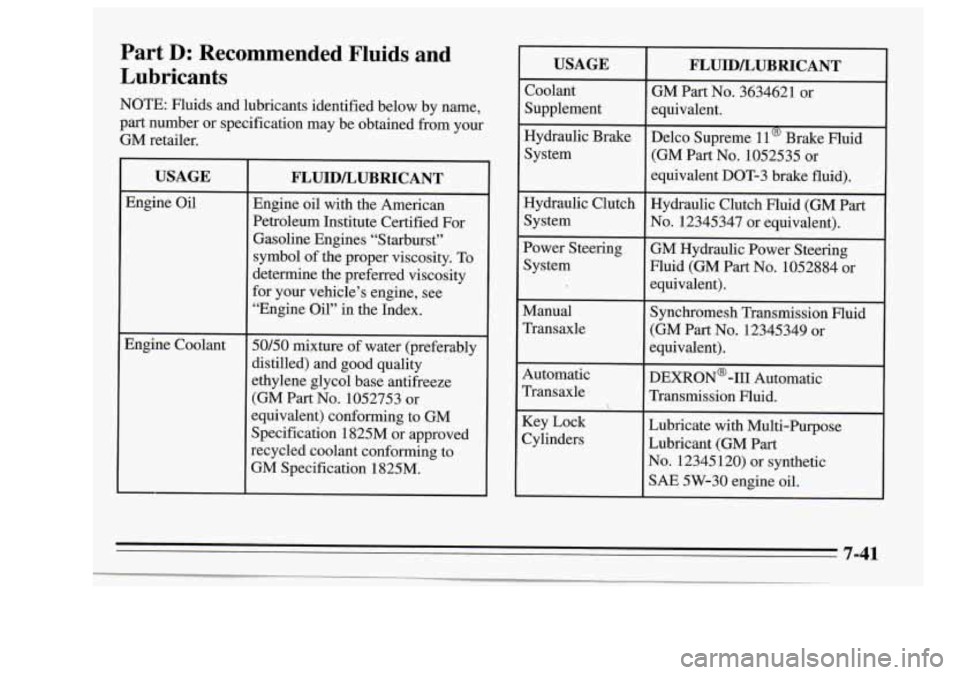
Part D: Recommended Fluids and
Lubricants
NOTE: Fluids and lubricants identified below by name,
part number or specification may be obtained from your
GM retailer.
USAGE
Engine Oil
Engine Coolanl
FLUIDLLUBRICANT
Engine oil with the American
Petroleum Institute Certified For
Gasoline Engines “Starburst”
symbol of the proper viscosity. To
determine the preferred viscosity
for your vehicle’s engine, see
“Engine Oil” in the Index.
50/50 mixture of water (preferably
distilled) and good quality
ethylene glycol base antifreeze
(GM Part
No. 1052753 or
equivalent) conforming to
GM
Specification 1825M or approved
recycled coolant conforming to
GM Specification
1825M.
USAGE
Coolant
Supplement
Hydraulic Brake System
Hydraulic Clutch
System
Power Steering
System
Manual
Transaxle
Automatic
Transaxle
Key Lock
Cylinders
FLUIDLUBRICANT
GM Part No. 3634621 or
equivalent.
Delco Supreme
11 @ Brake Fluid
(GM Part No. 1052535 or
equivalent
DOT-3 brake fluid).
Hydraulic Clutch Fluid
(GM Part
No. 12345347 or equivalent).
GM Hydraulic Power Steering
Fluid (GM Part
No. 1052884 or
equivalent).
Synchromesh Transmission Fluid
(GM Part No. 12345349 or
equivalent).
DEXRON@-III Automatic
Transmission Fluid.
Lubricate with Multi-Purpose
Lubricant
(GM Part
No. 12345 120) or synthetic
SAE 5W-30 engine oil.
7-41